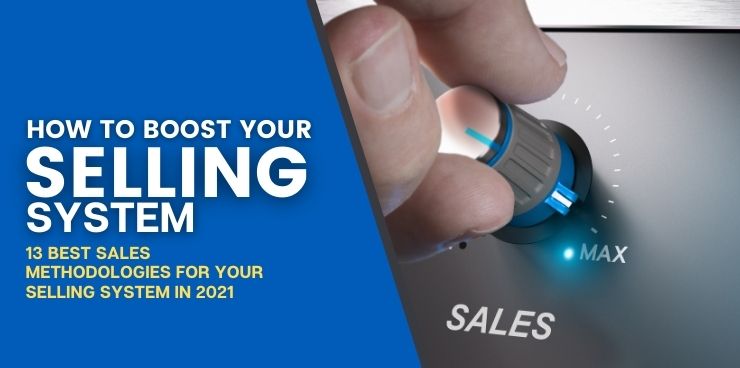There are a lot of approaches to selling. Which sales methodology is best depends on who you ask, especially if they’re selling their own method. We’ve compiled a list of the 13 best sales methodologies:
- Consultative Selling.
- Conceptual Selling (Miller Heiman).
- The Challenger Sales Model.
- SPIN Selling.
- SNAP Selling.
- Inbound Selling.
- MEDDIC.
- NEAT Selling.
- The Sandler Selling Method.
- Solution Selling.
- Target Account Selling.
- Value Selling.
- Customer-Centric Selling.
This article will examine each approach and evaluate how it can be incorporated into your best practices. After all, a winning method drives the conversion of your sales leads. It is also crucial to have guidelines in place for your sales team so they can reach their targets efficiently.
Consistency is key in building your brand, and adopting a uniform approach to sales is part of that. Understanding the sales cycle is just the beginning. Especially when using online leads, your sales reps need a clear philosophy to follow in order to sell successfully.
First, we need to understand what a sales methodology is.
What is Sales Methodology?
Sales methodology is the set of guidelines by which you sell goods or services to your customers. It is a part of the sales process and dictates how your salespeople interact with customers. Sales methodologies are frequently based on a particular philosophy of selling.
Experts have been researching customer psychology and optimum sales strategies for decades. There are a variety of methods to choose from and adapt to your business. These aren’t universal approaches. So, there may be some trial and error to find what works for your business.
The strategy you choose will inform your sales team on how to get from goals to sales. It is crucial to consider your market and which methods will be a good fit for your company’s mission. Implementing a sales model is imperative to achieve uniform sales practices.
A good way to identify appropriate sales approaches is to look at your target demographics. You can roughly match the age of methods to age demographics, for example. Looking at methods that work well with your targets and within the same market as your business will help as well. It is best to keep proven techniques in mind, though.
Sales Methodology vs. Sales Process
The sales process describes the set of steps, traditionally seven, of taking a lead and turning them into a customer. How your team moves from step to step depends on their sales methodology. Choosing a workable method for each step makes the sales process run smoothly and efficiently.
Depending on which philosophy you look at, there may be fewer or more steps to the sales process. Some methods focus on certain steps while others are more general. You may choose to combine methods or just use one, depending on your company’s needs.
The 13 Best Sales Methodologies in 2021
Successful entrepreneurs each have their own approach to sales. Some even trademarked their methods and made them into products themselves. Many of the most well-known methods are of this variety, but that doesn’t necessarily invalidate them.
Here are some of the top sales methods in 2021.
 Consultative Selling
Consultative Selling
Mack Hanan popularized the consultative selling method in his book by the same name. This method is highly customer-focused and depends on leveraging the sales rep’s expertise. The goal of this method is to guide the customers to identifying their needs and deciding how to solve them.
Consultative selling has six steps:
- Prepare.
- Connect.
- Understand.
- Recommend.
- Commit.
- Act.
This method seeks to cover all parts of the buyer journey and sales process. Companies can implement consultative selling for each team from marketing to account maintenance.
By asking qualifying questions, the sales rep gets the customer to think about problems they might not have recognized. Rather than push a sale, consultative selling has the sales rep focus on doing what’s best for the customer. This is a great method for markets grounded in reputation and earning customer trust.
Conceptual Selling
Conceptual selling is also known as the Miller Heiman method, named for its creators Robert Miller and Stephen Heiman. This approach focuses on selling a concept to the customer instead of a product. The concept is the customer’s desired outcome, which the salesperson can determine from getting to know the customer.
The conceptual selling method suggests five types of questions to identify the client’s end goal:
- Confirmation questions.
- New information questions.
- Attitude questions.
- Commitment questions.
- Basic issue questions.
These five question categories allow the salesperson to gain valuable insight into the customer’s situation. How the customer answers will determine the concept the seller can offer as a solution.
Like consultative selling, this method works well in markets based on reputation. The goal is to create and engage in a symbiotic relationship with the customer. Sales should offer a great deal of satisfaction for the customer in addition to the business.
The Challenger Sales Model
The Challenger sales model hinges on a set of five seller archetypes:
- The Hard Worker.
- The Relationship Builder.
- The Lone Wolf.
- The Reactive Problem Solver.
- The Challenger.
Authors Matthew Dixon and Brent Adamson introduced this methodology in their 2011 book, “The Challenger Sale.” They claim the Challenger archetype has the most successful salespeople by far. The idea of the Challenger is a salesperson who challenges the customer and takes control.
The basic philosophy of this method is that contemporary prospects are more informed than they were in the past. Therefore, a successful sales rep will teach, tailor their communication and take control of the narrative. This is a good strategy for specialized industries where customers are getting a lot of information online.
SPIN Selling
SPIN selling is a more traditional approach to sales that focuses on identifying the problem customers want to solve. Neil Rackham developed this approach in 1988, so it may be outdated for some markets. SPIN is an acronym for the four questions sales reps should ask potential customers:
- Situation.
- Problem.
- Implication.
- Need-Payoff.
The basic idea is that sellers should identify the problem the prospect has and present their product as the solution. SPIN selling deals entirely with the first half of the buying process. Therefore, you may need a separate approach for the second half of the buying process.
SNAP Selling
Jill Konrath introduced SNAP selling in her 2012 book of the same name. The basic assumption of SNAP selling is that contemporary customers are busy and want simple solutions. Sellers can help their potential customers by following the four principles of SNAP:
- Simple.
- iNvaluable.
- Aligned.
- Priority.
SNAP selling is meant to be fast and uncomplicated so customers don’t have to spend a lot of time or effort. Successful SNAP sellers understand that customers’ time is valuable and use that to their advantage to offer time-saving solutions.
Inbound Selling
Inbound selling focuses on marketing to entice customers to engage with businesses. It is the opposite of outbound selling, where salespeople reach out to leads directly. This method is focused on procuring online leads who are already interested in the company’s products.
The midpoint of the buyer journey where customers engage company websites and social media is where this method takes off. Sales reps reach out to qualified leads using personalized messaging and reel them in toward a sale. This is a great method for younger markets who don’t respond as well to outbound selling.
MEDDIC
MEDDIC is an acronym that stands for:
- Metrics.
- Economic Buyer.
- Decision Criteria.
- Decision Process.
- Identify Pain.
- Champion.
MEDDIC is a sales methodology that is based on efficiency. Sales reps identify which potential sales are most worthwhile and focus their efforts on them. This method eliminates wasted time from attempts to win sales from all prospects rather than only the best leads. MEDDIC is best suited for B2B companies.
 NEAT Selling
NEAT Selling
It is another method focused on efficiency, though it emphasizes getting to know the customer. NEAT is another acronym, and it stands for:
- Need.
- Economic Impact.
- Access to Authority.
- Timeline.
Sales Hacker Inc. and Harris Consulting Group developed NEAT selling as an alternative to BANT selling. BANT is basically the reverse of NEAT and focuses on how to win sales. NEAT focuses on qualifying leads by learning how the seller’s product can help solve the customer’s problem.
The Sandler Selling Method
Sandler Training, founded in 1967, introduced the Sandler Selling System as a B2B sales methodology. The key to the Sandler method is reframing salespeople into advisors and using that to build relationships with customers.
Using a seven-step process, the Sandler method has sellers view the customers’ success as their own success:
- Establish rapport.
- Set expectations and roles.
- Identify the customer’s needs and problems.
- Understand the customer’s budget they can use to implement a solution.
- Identify the customer’s decision-making process.
- Present the product as a solution.
- Win the sale.
In this way, the seller creates a bond with the customer and vice versa. This is a great method for turning one-time sales into account maintenance relationships, ensuring continued business with the customer.
Solution Selling
Solution selling is similar to conceptual and consultative selling. It emphasizes identifying with the customer and creating tailored solutions to customer problems. It also focuses on identifying those problems and working with the customer to develop the solution.
Rather than focusing on product sales, this method shifts to creating customized packages. Solution selling fosters high customer satisfaction by treating customers as individuals. This is an ideal method for companies that sell services or customizable products.
Target Account Selling
Similar to the Sandler method, target account selling focuses on identifying key prospects. However, target account selling involves heavy research into ideal accounts and companies can even automate this process. CRM software is especially helpful for this method.
Sellers can easily combine this approach with other sales methods. Because target account selling focuses on aggregating highly convertible prospects, reps can use different methodologies for sales. Target account selling is all about sales lead management.
Value Selling
Value selling is another strategic selling method ideal for B2B companies. It entails sellers emphasizing the value of their product to qualified leads. Similar to target account selling and the Sandler method, value selling also involves focusing on key prospects.
Value selling places heavy emphasis on lead qualification and creating a mutually beneficial deal between seller and customer. For this reason, the propagation of good leads is integral to using value selling successfully.
Customer-Centric Selling
John Holland, Michael Bosworth and Frank Visgatis introduced the idea of customer-centric selling in their book of the same name. This method is all about relationship building and getting to know the customer. It even goes a step further and has the seller arrange the sales process to fit the customer.
In customer-centric selling, sales reps focus entirely on the customer’s needs. They may even walk away from the prospect if the product won’t meet the customer’s needs. Customer-centric selling is a departure from traditional sales tactics that push the customer to buy.
Every company with a sales component needs a sales methodology to complement its sales process. While it may take some trial and error to determine which method will be a good fit, the process is necessary. Companies can also implement multiple strategies to create the best process possible for their business.
An ideal sales methodology will foster company growth through meaningful selling. Most modern sales approaches focus on the customer where traditional methods emphasize selling. While sales are the ultimate goal, the buyer journey doesn’t end at the sale transaction. Traditional sales methods neglect the latter part of the buying process and can lose opportunities for continued interaction.
With these 13 best sales methodologies of 2021, you can enhance your selling system. Not only can a good selling approach increase sale quantity, but it can also improve sale quality.
To read more about how you can grow your business, check out our blog here. But don’t stop there; we offer specialized solutions for your business and can help you achieve long-term growth. Book a call with us today and see the difference.


 Consultative Selling
Consultative Selling NEAT Selling
NEAT Selling